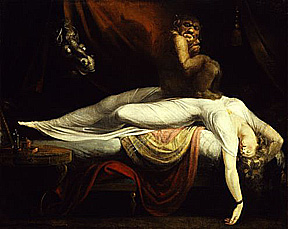
CONTACT US
INVESTIGATIONS
EVENTS/CLASSES
IS IT A GHOST
ALIENS
YOUR GHOST STORIES
BOOK INTERVIEWS
Nocturnal Encounters
Sleep Paralysis and Nightmares as
Related to Ghostly Appearances

Many encounters with the supernatural are preceded being asleep. The typical testimony will include statements such as;
I woke up and sensed something
in the room with me
I was unable to move
The figure standing there was
blurry maybe it was a dream
I was unable to breathe as if
someone or something was sitting on my chest
I could hear something unnatural
moving about
I knew it was an evil entity
When investigating ghostly
encounters we are faced with the problem of whether
the source of the apparition was external (ghosts
and spirits) or internal (nightmares and/or
hallucinations). The internal aspect is
associated with a sleeping disorder known as Sleep
Paralysis (SP) and the sensory experiences that
accompany SP are referred to as
Hypnagogic/Hynopompic Experiences (HHE).
The Dream State of the
sleeping cycle is identified by Rapid Eye Movement
(REM). The eyes move about in an attempt to scan the
images that are generated in the visual areas of the
brain. Another condition associated with REM is that
the body becomes atonic (lacking muscle
control). This is a natural function that
prevents the body from reacting to what is seen in
the dream. Without this we would probably awake
every morning battered and bruised, not to mention
the damage done to our partners. Upon waking muscle
control is quickly regained except during SP.
It is suspected that the bodies ability to wash out
the atonia is compromised. This state of paralysis
is often interpreted as a feeling of being
restrained or being frozen with fear. SP can also be
accompanied by difficulty or shortness of breath,
which accounts for reports of being sat upon or
feelings that some great weight is pressed on the
victim.
Most individuals that
experience SP also have HHEs. These are defined as
hallucinatory states, hypnogogic refers to sleep
onset and hypnopompic to wakening. A hallucination
has to have several qualities:
1) It has to have the sensation
of being caused by an event
externally not in ones
head. Not just imagination or
an idea.
2) The cause of the event is beyond
the control of the
percipient.
3) The event has to feel real
enough that the percipient
believes it could be verified by an
independent
observer.
It is not clear whether the
hallucinations are a result of the mind trying to
sort out the possible cause of the symptoms along
with the heightened anxiety of being paralyzed or
whether the hallucinations are intrinsic part of SP.
There are common features to
sleep paralysis and hypnagogic/hypnopompic
hallucinations. The percipient has the
feeling of being awake and unable to move.
Their eyes open and close and are able to visually
scan. Feelings of pressure on the chest are the most
common, however, sensations of being held down,
choked or smothered have also been reported. There
are usually auditory experiences of footsteps,
shuffling or breathing. Visual aspects include
ghostly forms, amorphic creatures that are
indistinct, shadows with eyes that are the most
prominent feature and animal likenesses. The feeling
of malevolence is the most striking and
typical aspect of this type of encounter. The
interpretation of the presence generally is one of
evil intent it is death, it is there to do harm or
to attack, or even to sexually molest.
David J. Huffordís book The Terror
That Comes In The Night has many case studies that
highlight this phenomenon. He first noticed these
symptoms in people that reported being attacked by
an "old hag while asleep. The old hag is a common
description in Newfoundland. It is believed
that while sleeping this old hag holds you down and
if not awakened you will die. Hufford found that
people reported the same symptoms in other areas
around the world, however, they were interpreted
differently as ghosts, demons (esp.
incubus/succubus), vampires etc.. This gives rise to
the idea that this phenomenon is experience based
not culturally based. An attempt to explain
what happened is a synthesis of the experience
through cultural knowledge.
When doing investigations we
inquire about the percipient's dreams and sleeping
habits. It is important to establish any sleep
disorders that may account for their sighting(s).
Keep in mind that even if someone has had this
problem in the past it does not negate the impact or
veracity of their statement. There is still a
lot of research to be done into this phenomenon and
the exact purpose and process of dreaming. There are
many involved in the paranormal that believe that
dreams are one possible avenue for the dead to
communicate. Any serious investigation should
include questions regarding this subject in order to
establish a database that may eventually establish a
more concrete explanation for this supernatural
event.
